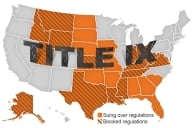You have /5 articles left.
Sign up for a free account or log in.

The government is gearing up to dole out the next $45 million in the grant program after starting with an initial $5 million allocation from Congress.
Photo illustration by Justin Morrison/Inside Higher Ed | Getty Images | Rawpixel
Fourteen thousand students dropped out of the Austin Community College District in Texas during the last two academic years. But the institution of more than 36,000 students has a plan to get some of them back.
Supported by a $770,765 Education Department grant, that plan involves reaching out to students and connecting them with career services, financial aid and other campus resources, along with re-enrollment coaching and advising services. By the end of next year, officials at the college aim to have a better idea of why students stop out, how to keep them in school in the first place and how to use campus resources more effectively to support them.
“Hopefully we get our students back—that’s the ultimate goal,” said Guillermo Martinez, associate vice chancellor of student engagement and academic success at Austin Community College.
The college was one of five institutions that received the first round of federal money from the new Postsecondary Student Success Program, which funds evidence-based programs and strategies designed to improve outcomes for underserved students. Congress created the program two years ago and expanded it last year, but its funding for 2024 is uncertain as lawmakers work to pass a federal budget.
Advocates say the grant program is a needed investment at a time when the national college completion rate is just 62 percent and the number of students who have stopped out has increased to an estimated 40 million. Despite the divisions in Congress and funding constraints, higher education advocates are hopeful that Congress will continue to fund the program, which has bipartisan support, when it ultimately passes a budget this fall.
Despite representing a fraction of the federal budget for higher education, the program can provide a strong return on investment, advocates say, adding that this is an area where a little bit of money can go a long way.
For the next fiscal year, the Biden administration sought $165 million for the program. The Senate is planning to keep Student Success funding flat at $45 million, which likely would be the best-case scenario for advocates this budget cycle. The details of the House’s education budget haven’t been released yet, but House Republicans are eyeing a number of cuts to the Education Department.
“In this political climate, having it maintained at $45 million would be great,” said Tanya Ang, managing director of advocacy at Higher Learning Advocates, a nonprofit that works to improve outcomes for students.
A Focus on Evidence
President Biden called on Congress in May 2021 to create a $62 billion College Completion Fund as a way to increase retention and completion rates. That proposal eventually morphed into the Postsecondary Student Success Program, which Congress funded with $5 million in March 2022 as part of the fiscal year 2022 budget. Congress then increased the pot of money to $45 million for 2023.
The first $5 million was awarded late last year, and the new grant cycle is just getting underway. The $45 million is expected to go to eight to 12 programs, with awards ranging from $3 to $7 million, according to an application notice. Historically Black colleges or universities, tribally controlled colleges or universities, minority-serving institutions and community colleges are eligible to apply, along with states or nonprofits that are partnering with those institutions. Grant proposals need to be backed by evidence or meet What Works Clearinghouse standards.
“The department believes that targeting funding to these [institutions of higher education] is the best use of the available funding because these institutions disproportionately enroll students from groups who are underrepresented among college completers, such as low-income students,” the notice says.
For the initial $5 million, more than 100 institutions applied for funding, highlighting the strong demand for the program, according to a fact sheet from the Institute for College Access and Success.
Michelle Dimino, deputy director of education at Third Way, a center-left think tank, said the federal government has historically focused on helping students make it to college, but the focus has shifted over the years to retaining and graduating those students. The Student Success program was the first federal funding effort of its kind focused on scaling up proven retention and completion initiatives.
“It shows recognition from the federal government that we need to invest in really ensuring that all students that enter higher education make it through to the degree or credential that they want, and that has positive effects for everybody,” she said.
The grant program is “one of the most exciting things” in higher education right now, Dimino said, because of its emphasis on evidence-based solutions and underserved students.
“It’s really unique in that regard to be investing in proven programs and practices that we know help more students get through to graduation,” Dimino said. “To be able to focus those efforts on MSIs and HBCUs and tribal colleges and community colleges, it’s really putting a lot of attention in exactly the right spots, and we know that it’ll have a positive impact because that evidence base is required to get there.”
Improving Outreach and Student Support Services
Austin Community College was notified of its grant late last year, and since then it has hired two staff members to work on the program, along with a consultant. The college also is contracting with InsideTrack, a company that specializes in coaching programs, to reach out to students who have stopped out and provide them with support.
The college’s goal is to reach out to 7,000 of the stop-outs. The other 7,000 will be considered a control group, allowing the college to run an experiment to see if its outreach, coaching, advising and other support systems actually work.
“There’s no way without the grant support that we would have been able to reach out to the 7,000,” Martinez said. “If we didn’t have the grant, we probably could have reached out to maybe 1,000 or 2,000 students.”
Martinez said college staff have already called 1,000 students, 30 percent of whom picked up the phone. About half said they want to return to college. Martinez said he wants to use the grant to better leverage data to learn more about students and how to help them.
“We struggle—not just at ACC but I think in higher ed—with knowing our students well enough to give them what they need,” he said. “I think what we’ve been trying to do a lot more lately is digging deep into understanding who our students that we serve today are and figuring out how we can best support them.”
The other institutions picked for the initial round of funding—Florida International University, Passaic County Community College in New Jersey, Orangeburg-Calhoun Technical College in South Carolina and Claflin University, also in South Carolina—are taking similar approaches.
Ang said that students who see the most success tend to receive a range of services that support not only their academics but also basic needs such as childcare or food, which the grant program can fund. She hopes that institutions and the Education Department will use a “chunk” of the $45 million to provide money directly to students to support their mental health or address food insecurity. That approach would be similar to how part of the COVID stimulus money provided to colleges and universities was used to provide aid directly to students and help them stay enrolled.
“We’re seeing significant challenges again with today’s students in higher education, and schools are maxed out as far as what they can do and the resources they can provide,” Ang said.
Kyle Southern, associate vice president for higher education quality at TICAS, said the grant funding can help expand access to programs that have a proven track record of improving outcomes for students and provide information about other interventions that could increase completion rates.
“This is really the kind of program that shows how the federal government can work best, which is to support innovative but also evidence-backed interventions that can enhance access and equity to improve outcomes and lead to better jobs and better lives for—hopefully down the line—hundreds of thousands if not millions more students,” he said.
Southern added that, while the funding is welcome, $45 million is “nowhere near the kind of investment that can or should be made in what we know works to improve completion rates for students nationwide.”
To protect current funding levels and advocate for more, Southern said elevating stories of students who’ve been helped by programs like Austin Community College’s will be crucial.
“The numbers are really important, but we’re talking about lives that have been fundamentally changed by often not a huge investment,” he said. “A lot of people are one car problem or an unexpected medical bill away from stepping away from higher education.”








